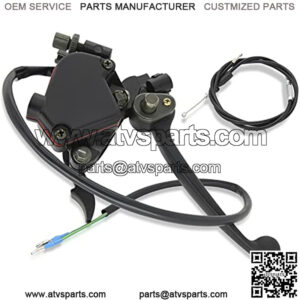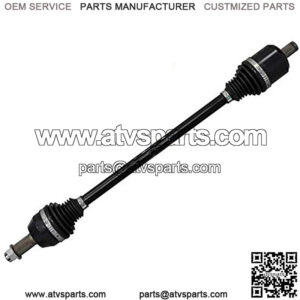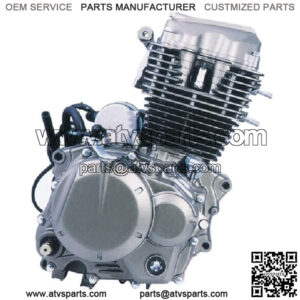An ATV (All-Terrain Vehicle) Throttle Control refers to the mechanism or device used to regulate the engine’s throttle on an ATV. The throttle controls the amount of fuel and air mixture that flows into the engine, determining the engine’s power output and ultimately controlling the vehicle’s speed.
ATVs typically have a hand-operated throttle control located on the handlebars. When the rider twists the throttle grip, it opens the throttle valve in the engine’s carburetor or throttle body, allowing more fuel and air to enter the combustion chamber. This increased fuel and air mixture leads to higher engine RPM (Revolutions Per Minute) and more power, causing the ATV to accelerate.
The throttle control is a critical component of an ATV, as it provides the rider with the ability to control the vehicle’s speed and maneuverability. It allows the rider to smoothly accelerate or decelerate as needed while riding on various terrains.
Moreover, modern ATVs may be equipped with electronic throttle controls, also known as “throttle-by-wire” systems. In these setups, the throttle grip is connected to sensors that send signals to the ATV’s engine control unit (ECU). The ECU then adjusts the throttle electronically, providing more precise control over the engine’s performance and enabling additional features like traction control and electronic stability control.
It’s essential for ATV riders to understand how to operate the throttle control safely and responsibly to ensure a smooth and enjoyable riding experience while minimizing the risk of accidents.
An ATV (All-Terrain Vehicle) Throttle Control refers to the mechanism or device used to regulate the engine’s throttle on an ATV. The throttle controls the amount of fuel and air mixture that flows into the engine, determining the engine’s power output and ultimately controlling the vehicle’s speed.
ATVs typically have a hand-operated throttle control located on the handlebars. When the rider twists the throttle grip, it opens the throttle valve in the engine’s carburetor or throttle body, allowing more fuel and air to enter the combustion chamber. This increased fuel and air mixture leads to higher engine RPM (Revolutions Per Minute) and more power, causing the ATV to accelerate.
The throttle control is a critical component of an ATV, as it provides the rider with the ability to control the vehicle’s speed and maneuverability. It allows the rider to smoothly accelerate or decelerate as needed while riding on various terrains.
Moreover, modern ATVs may be equipped with electronic throttle controls, also known as “throttle-by-wire” systems. In these setups, the throttle grip is connected to sensors that send signals to the ATV’s engine control unit (ECU). The ECU then adjusts the throttle electronically, providing more precise control over the engine’s performance and enabling additional features like traction control and electronic stability control.

It’s essential for ATV riders to understand how to operate the throttle control safely and responsibly to ensure a smooth and enjoyable riding experience while minimizing the risk of accidents.
The role of ATV throttle control is to regulate the amount of power the engine produces and, consequently, the vehicle’s speed and acceleration. It is a fundamental mechanism that allows the rider to control the ATV’s movement while navigating various terrains and riding conditions. The throttle control plays a crucial role in the overall operation and safety of the ATV. Here are some specific roles and functions of ATV throttle control:
- Speed Regulation: The primary purpose of the throttle control is to adjust the engine’s RPM and, consequently, the speed of the ATV. When the rider twists the throttle, it opens the throttle valve, allowing more fuel and air into the engine. This leads to increased engine power, higher RPM, and faster acceleration. Conversely, releasing the throttle reduces power, RPM, and speed.
- Maneuverability: Proper throttle control enables the rider to maneuver the ATV effectively. When navigating through tight spots, rough terrain, or obstacles, a delicate manipulation of the throttle allows the rider to maintain the appropriate speed and control over the vehicle.
- Smooth Acceleration and Deceleration: A well-functioning throttle control allows for smooth and gradual acceleration, which is crucial for maintaining control over the ATV and preventing jerky movements that may lead to instability or accidents. Similarly, controlled deceleration helps bring the vehicle to a stop smoothly.
- Climbing and Descending: When tackling inclines or steep descents, the rider can adjust the throttle to match the terrain’s demands. For uphill climbs, a bit more throttle may be required to maintain momentum, while controlled throttle reduction helps control speed on downhill sections.
- Traction Control: Some modern ATVs come equipped with advanced electronic throttle control systems that provide traction control features. These systems can adjust the throttle response to prevent wheel slippage on slippery or loose surfaces, improving overall traction and stability.
- Fuel Efficiency: By controlling the throttle, the rider can manage fuel consumption. Riding at a steady speed with controlled throttle inputs can help conserve fuel and extend the ATV’s range.
- Safety: Proper throttle control is essential for safe riding. Sudden and aggressive throttle inputs can lead to loss of control, wheel spin, or accidents. Consistent and careful throttle management enhances the rider’s ability to respond to changes in the terrain or unexpected obstacles.
Overall, the ATV throttle control is a critical component that empowers the rider to navigate various environments safely and efficiently. Understanding how to use the throttle properly, in combination with other riding techniques, contributes to an enjoyable and secure off-road riding experience.
About ATV (All-Terrain Vehicle) Throttle Control
atv all terrain vehicle
atc all terrain cycle
all-terrain vehicle (atv)
atv throttle assembly
throttle atv
best atv throttle extender





